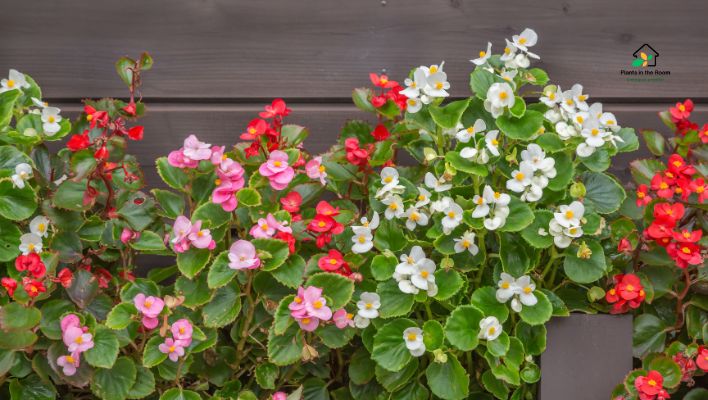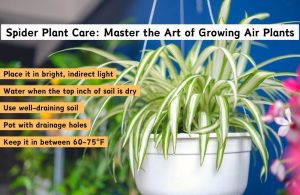This article covers the following areas –
- Types of Begonias: Variety of Species
- Choosing the Right Begonia for Your Space
- Essential Begonia Care Tips
- Propagation of Begonias from Cuttings
- How to Repot Your Begonias
- Common Begonia Pests and Problems
- Pruning and Grooming Your Begonia
- Final Note
- Get to Know Your Begonia
As a plant enthusiast, I’ve grown to love the beauty and versatility of indoor plants, especially begonias. These charming plants have found a special place in my home, and I’m excited to share my knowledge and experience in growing healthy begonias with you. In this post, I’ll cover everything you need to know to grow happy and healthy begonias.
To care for begonias, place them in bright, indirect sunlight. Water when the top inch of soil feels dry, and avoid wetting the leaves. Maintain high humidity with a pebble tray or humidifier. Fertilize every 4-6 weeks during the growing season, and prune regularly to promote bushiness.
Now, let’s talk about various types of begonias first and then the essential care tips, propagation and repotting techniques, common pests and problems, and decorative ideas for displaying your begonia.
Types of Begonias: Variety of Species
Over the years, I’ve come to appreciate the diversity of begonias, which comprise over 2002 species. Here, I will discuss four main types of begonias that have thrived in my indoor garden:
#1 Rex Begonias
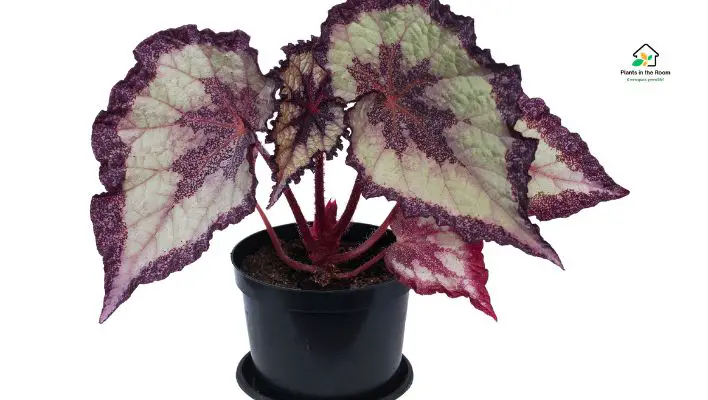
I adore Rex begonias for their vibrant and intricately patterned foliage. These eye-catching plants boast a diverse range of leaf colors, shapes, and textures. While Rex Begonias may appear delicate, they are relatively easy to care for with the right attention to their light, water, and humidity needs.
#2 Rhizomatous Begonias
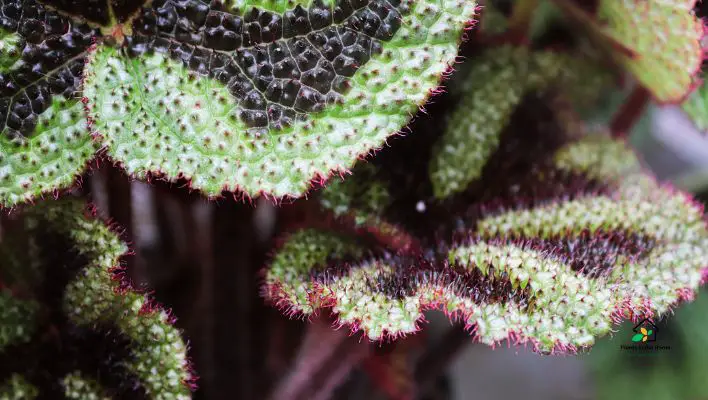
Rhizomatous Begonias are known for their thick, creeping rhizomes that grow horizontally along the soil surface. They are also admired for their striking foliage, which displays various colors, patterns, and textures. To ensure their health and vigor, provide Rhizomatous Begonias with bright, indirect sunlight, consistent moisture without waterlogging, and a humid environment.
#3 Tuberous Begonias
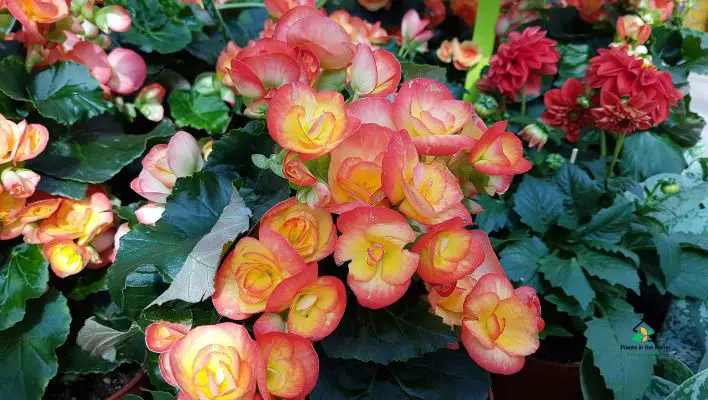
Tuberous Begonias are a stunning variety of begonias known for their large, brilliantly colored flowers that can create a spectacular display in any garden or indoor setting. These gorgeous plants grow from tubers, which store energy for lush growth and abundant blooms during their growing season.
Tuberous Begonias are ideal for hanging baskets, window boxes or as a bold addition to a shaded garden bed.
#4 Fibrous-rooted Begonias
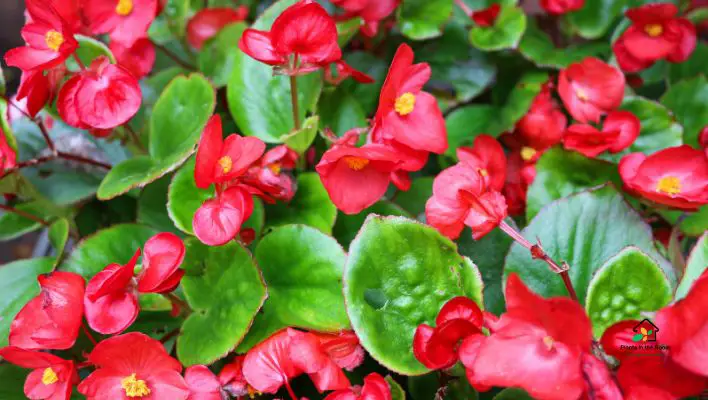
Fibrous-rooted Begonias are a versatile and resilient group of begonias, recognized for their dense, fibrous root systems that form a sturdy base for the plant. These begonias are cherished for their attractive foliage and charming flowers that bloom throughout the growing season.
Fibrous-rooted Begonias make excellent additions to indoor and outdoor gardens, thriving in containers, hanging baskets, or colorful accents in shade or part-sun beds.
Choosing the Right Begonia for Your Space
To find the perfect begonia for your space, consider your environment and how it aligns with the plant’s needs. Here’s how to choose the right begonia for your home.
Assessing Your Environment
Evaluate the light, humidity, and temperature in your living space. Begonias typically prefer bright, indirect sunlight, humidity levels around 50-60%, and moderate temperatures between 65-75°F (18-24°C) during the day.
Identify areas in your home that meet these conditions or determine if you need to adjust your environment with grow lights, humidifiers, or temperature control.
Matching Begonia Type to Your Needs
With numerous begonia varieties, selecting one that fits your environment and complements your existing plants is essential. Consider the following factors.
1) Light requirements: Some begonias, like Rex Begonias, are more sensitive to direct sunlight and require filtered light, while others, like fibrous-rooted begonias, can tolerate more light.
2) Humidity and moisture preferences: Rex and Rhizomatous Begonias need higher humidity levels and consistent moisture, while other types may be more forgiving. If your home has low humidity, choose a variety that can better adapt to your environment.
3) Growth habit and size: Consider the available space and desired appearance. Tuberous Begonias produce stunning flowers, making them ideal for visual impact. Rex Begonias showcase eye-catching foliage, while fibrous-rooted and rhizomatous varieties offer a balance of attractive leaves and delicate flowers.
4) Maintenance level: Some begonias require more care than others. Tuberous Begonias need a dormancy period, while fibrous-rooted Begonias tend to be low-maintenance. Choose a variety that matches your gardening experience and time commitment.
Essential Begonia Care Tips
As a begonia caretaker and lover, I’ve discovered several essential tips for keeping my plants healthy and happy, ensuring they flourish in any environment:
#1 Providing Proper Lighting
Begonias require bright, indirect light to thrive. I place my begonias near windows with filtered light or use a grow light if needed to avoid direct sunlight that may scorch the leaves. My begonias can grow strong and produce vibrant foliage and flowers by ensuring the right lighting conditions.
#2 Watering Techniques for Healthy Growth
Proper watering is crucial for begonia’s health. I water my begonias when the top inch of the soil feels dry, avoiding overwatering, which can lead to root rot. To ensure even moisture distribution, I water the plant’s base, avoiding wetting the leaves to prevent fungal issues. Using a well-draining potting mix also helps prevent waterlogging and promotes healthy root growth.
#3 Ideal Temperature and Humidity Levels
Begonias prefer temperatures between 65-75°F (18-24°C) and humidity levels above 50%. I maintain these conditions by using a humidifier or a pebble tray with water and keeping my begonias away from drafts, air conditioning vents, and heating sources that may cause temperature fluctuations. By maintaining a stable environment, my begonias can grow robust and healthy.
#4 Soil and Potting Mix Recommendations
Selecting the right potting mix is essential for begonia’s health. I use a well-draining, peat-based potting mix that provides the right nutrients and aeration for healthy root growth. Additionally, the mix should be slightly acidic, with a pH of around 5.5 to 6.5. I also ensure my begonias are planted in pots with drainage holes, allowing excess water to escape and preventing root rot.
Propagation of Begonias from Cuttings
Over time, I’ve learned how to propagate my begonias to keep them thriving, expand my collection, and share this love with others. And I’ve found propagation from leaf or stem cuttings to be an effective way to multiply your begonias. Here are what to do.
- For leaf cuttings, select a healthy, mature leaf and cut it along with a short section of the petiole. For stem cuttings, choose a healthy, non-flowering stem with at least one leaf node and make a clean cut below the node.
- Dip the cut end of the cutting in rooting hormone to stimulate root growth (optional).
- Prepare a small pot with moist, well-draining potting mix. For leaf cuttings, insert the petiole into the soil, while for stem cuttings, plant the cut end with the node just below the soil surface.
- Cover the pot with a plastic bag or place it in a propagation chamber to maintain high humidity.
- Place the pot in a warm spot with bright, indirect light, and monitor the soil moisture, keeping it consistently moist but not soggy.
- In a few weeks, new roots and shoots will emerge. Once the new plant has developed a robust root system and shows healthy growth, you can gradually acclimate it to normal conditions before transplanting it to a larger pot or its final location.
How to Repot Your Begonias
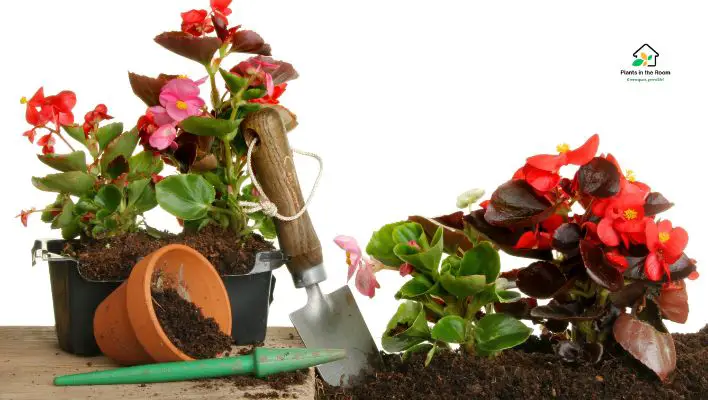
Caring for your begonias involves more than just providing the right light, water, and nutrients. To keep your plants thriving, it’s crucial to repot them periodically, ensuring they have ample space and fresh soil for continued growth. In this section, I’ll walk you through the key aspects of repotting begonias, including timing, pot selection, and the repotting process itself.
- Timing: Repot your begonias every 1-2 years or when they outgrow their containers, usually during the early spring or just before the active growing season.
- Choosing a pot: Select a pot that’s slightly larger (1-2 inches in diameter) than the current one and has drainage holes to prevent waterlogging.
- Repotting process:
- Water your begonia a few hours before repotting to make the process easier.
- Carefully remove the begonia from its old pot, supporting the base of the stem and the root ball.
- Gently tease apart any compacted or circling roots, encouraging better root growth in the new pot.
- Place a layer of fresh, well-draining potting mix at the bottom of the new pot, and position the begonia at the same depth it was in the old pot.
- Fill the pot with fresh potting mix, gently firming it down around the roots, and water the plant to settle the soil.
Common Begonia Pests and Problems
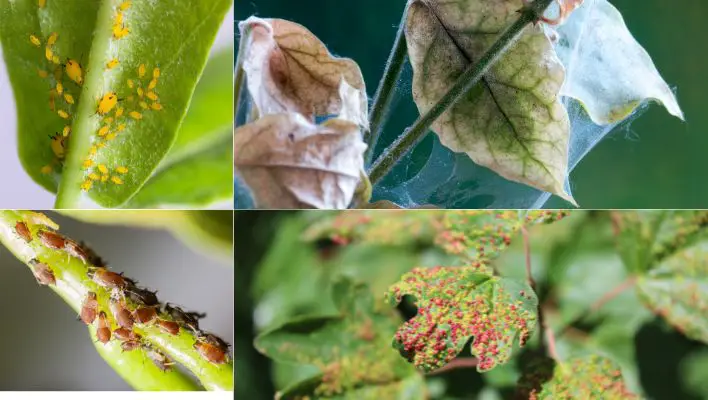
As with any plant, begonias may face challenges. Here are some common pests and problems I’ve encountered and how I’ve dealt with them.
A. Identifying and Treating Common Pests
- Spider mites: These tiny, spider-like pests feed on plant sap, causing yellowing or stippling on the leaves. They can be hard to spot, but you may notice fine webbing on the leaves.
- Mealybugs: These small, white, cottony insects also feed on plant sap, leading to yellowing leaves and stunted growth.
- Aphids: These small, pear-shaped insects cluster on new growth and the undersides of leaves, causing leaf curling, distortion, and yellowing.
To treat infestations, I inspect my begonias regularly and take action as soon as I spot any pests. I use insecticidal soap, neem oil, or a combination of both, applying according to the product’s label. In severe cases, I prune the affected parts of the plant or use a systemic insecticide.
B. Preventing and Managing Diseases
Begonias, although relatively easy to care for, can sometimes be affected by two common diseases: powdery mildew and root rot. Here, I’ll discuss the symptoms, prevention methods, and management strategies for these diseases to help you maintain the health and vitality of your begonias.
Powdery Mildew
This fungal disease appears as white, powdery patches on leaves and stems, causing distortion and stunted growth
To prevent powdery mildew, ensure proper air circulation around your begonias, avoid overhead watering, and keep the foliage dry.
Root Rot
This disease occurs when roots are damaged by overwatering or poorly-draining soil, leading to the plant’s decline and eventual death.
To prevent root rot, avoid overwatering and use a well-draining potting mix. Water only when the top inch of the soil is dry.
Pruning and Grooming Your Begonia
Keeping your begonias well-groomed and pruned not only ensures they look their best but also promotes their overall health and vigor.
A. Pruning for Plant Health and Shape
- Regular pruning: Prune your begonias regularly by removing dead leaves, spent flowers, and any leggy or weak growth. This helps maintain the plant’s shape, encourages bushier growth, and improves air circulation, reducing disease risk.
- Pinching back: For bushier plants, pinch back the growing tips of stems by removing the top 1-2 inches. This encourages branching and creates a fuller, more compact plant.
- Timing: The best time to prune begonias is in late winter or early spring, just before the growing season begins. However, you can remove dead leaves and flowers as needed throughout the year.
B. Grooming Tips for Optimal Appearance
- Cleaning leaves: Wipe the leaves of your begonias with a damp cloth or soft sponge to remove dust, dirt, and any small pests. This keeps the leaves looking vibrant and healthy, allowing them to photosynthesize more efficiently.
- Inspecting for pests: Watch for any signs of pests or diseases while grooming your begonias. Early detection and treatment are essential for maintaining the health of your plants.
- Supporting stems: Some begonia varieties may require staking or support to prevent their stems from breaking under the weight of heavy flowers or foliage. Use stakes, small trellises, or peony rings to provide the necessary support.
Final Note
Growing begonias has been a rewarding experience for me, and I’m confident that with these tips and guidelines, you can successfully cultivate a healthy indoor begonia garden. The beauty and variety of begonias make them an excellent addition to any home, and their relatively low maintenance requirements make them a joy to care for.
Happy planting!
Get to Know Your Begonia
| Indicator | Begonia |
|---|---|
| Family | Begoniaceae |
| Genus | Begonia |
| Common Name | Begonia |
| Origin | Central and South America, Africa, and Southeast Asia |
| Plant Type | Flowering perennial |
| Mature Size | Up to 1-4 feet in height, depending on variety |
| Growth Rate | Moderate |
| Light Requirements | Bright, indirect light |
| Watering Requirements | Regular, allowing the top inch of soil to dry between waterings |
| Soil Preference | Well-draining, peat-based potting mix |
| Temperature Tolerance | 65-75°F (18-24°C) |
| Humidity Tolerance | Moderate to high humidity |
| Fertilization | Every 3-4 weeks during the growing season with a balanced liquid fertilizer |
| Propagation | Stem or leaf cuttings, division, or tuber |
| Pests | Spider mites, mealybugs, aphids |
| Diseases | Powdery mildew, root rot |
| Toxicity | Mildly toxic to pets, non-toxic to humans |
| Special Features | Showy flowers and foliage, diverse range of varieties |
| Popular Uses | Indoor and outdoor decoration, container gardening, landscape plantings, hanging baskets, terrariums |

